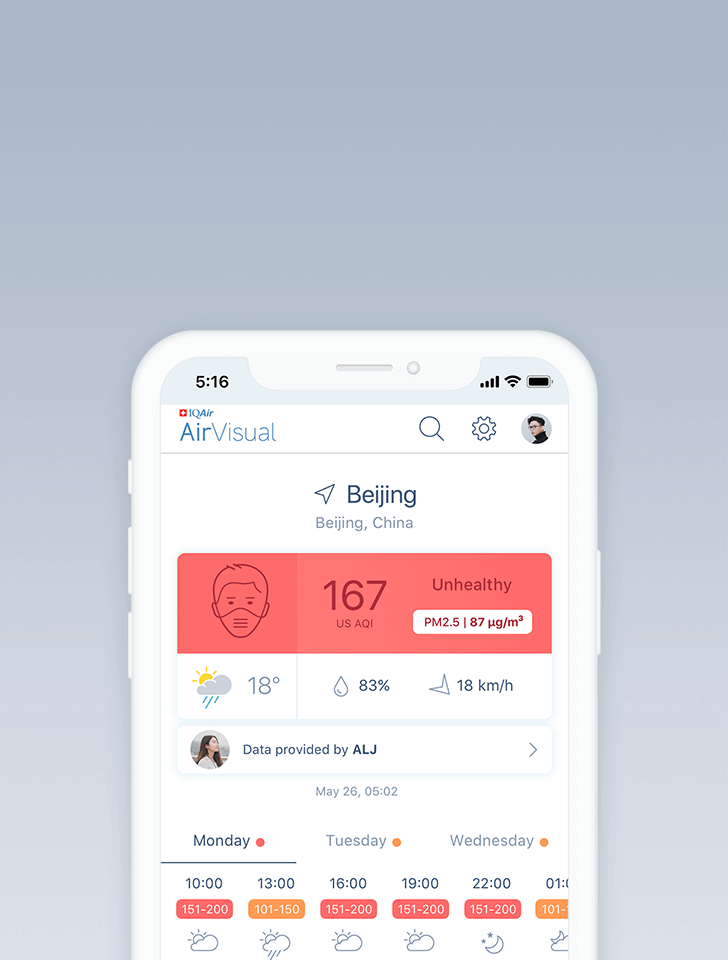Air quality in Bozhou
Air quality index (AQI) and PM2.5 air pollution in Bozhou
9.5K people follow this city

Bozhou Air Quality Map
Real-time Bozhou air pollution map
Weather
What is the current weather in Bozhou?
| Weather | Broken clouds |
| Temperature | 59°F |
| Humidity | 55% |
| Wind | 8.3 mp/h |
| Pressure | 29.8 Hg |
live aqi city ranking
Real-time China city ranking
| # | city | US AQI |
|---|---|---|
| 1 | Baotou, Inner Mongolia | 567 |
| 2 | Jining, Inner Mongolia | 476 |
| 3 | Ulanqab, Inner Mongolia | 475 |
| 4 | Hohhot, Inner Mongolia | 376 |
| 5 | Bayan Nur, Inner Mongolia | 228 |
| 6 | Ordos, Inner Mongolia | 217 |
| 7 | Hegang, Heilongjiang | 200 |
| 8 | Jiamusi, Heilongjiang | 167 |
| 9 | Yichun, Heilongjiang | 160 |
| 10 | Tongzhou, Beijing | 156 |
(local time)
SEE WORLD AQI RANKING3D animated air pollution map

live Bozhou aqi ranking
Real-time Bozhou air quality ranking
| # | station | US AQI |
|---|---|---|
| 1 | Sanguo lansheng gong | 82 |
| 2 | Haozhou Institute | 80 |
| 3 | Sewage plant | 78 |
| 4 | Wushui chuli chang | 70 |
| 5 | Bozhou University | 68 |
(local time)
SEE WORLD AQI RANKINGUS AQI
74
live AQI index
Moderate
Overview
What is the current air quality in Bozhou?
| Air pollution level | Air quality index | Main pollutant |
|---|---|---|
| Moderate | 74 US AQI | PM2.5 |
| Pollutants | Concentration | |
|---|---|---|
| PM2.5 | 23µg/m³ | |
| PM10 | 95µg/m³ | |
| O3 | 0µg/m³ | |
| NO2 | 11µg/m³ | |
| SO2 | 10µg/m³ | |
| CO | 300µg/m³ | |
PM2.5
x4.6
PM2.5 concentration in Bozhou is currently 4.6 times the WHO annual air quality guideline value
Health Recommendations
What is the current air quality in Bozhou?
| Sensitive groups should reduce outdoor exercise | |
| Close your windows to avoid dirty outdoor air GET A MONITOR | |
| Sensitive groups should wear a mask outdoors GET A MASK | |
| Sensitive groups should run an air purifier GET AN AIR PURIFIER |
Forecast
Bozhou air quality index (AQI) forecast
| Day | Pollution level | Weather | Temperature | Wind |
|---|---|---|---|---|
| Monday, Apr 22 | Moderate 95 AQI US | 80.6° 57.2° | ||
| Tuesday, Apr 23 | Unhealthy for sensitive groups 113 AQI US | 75.2° 57.2° | ||
| Wednesday, Apr 24 | Moderate 87 AQI US | 80.6° 51.8° | ||
| Today | Moderate 74 AQI US | 80.6° 51.8° | ||
| Friday, Apr 26 | Moderate 95 AQI US | 82.4° 57.2° | ||
| Saturday, Apr 27 | Unhealthy for sensitive groups 112 AQI US | 84.2° 60.8° | ||
| Sunday, Apr 28 | Unhealthy for sensitive groups 114 AQI US | 80.6° 59° | ||
| Monday, Apr 29 | Unhealthy for sensitive groups 101 AQI US | 64.4° 59° | ||
| Tuesday, Apr 30 | Moderate 83 AQI US | 69.8° 59° | ||
| Wednesday, May 1 | Moderate 78 AQI US | 64.4° 53.6° |
Interested in hourly forecast? Get the app
AIR QUALITY ANALYSIS AND STATISTICS FOR Bozhou
Is there a high level of air pollution present in Bozhou?
Bozhou is a city located in the northwestern side of Anhui province, which itself is part of the eastern region of China. Anhui province is a landlocked area, and the city of Bozhou itself borders other cities such as Fuyang, Henan, Bengbu and Huainan. In regards to its levels of air pollution, Bozhou sees some rather poor quality of air throughout much of the year, with many months coming in with high readings of PM2.5 and US AQI, both of which are used to measure the air pollution levels. In early May of 2021, Bozhou was seen with a US AQI reading of 159, a high number that would classify the city as being ‘unhealthy’ for that particular day and time in which it was taken.
Having an unhealthy reading indicates that the air is somewhat permeated by smoke, haze and all manner of fine particulate matter. When inhaled, these chemicals and tiny particles can wreak havoc on the human body, with the tiniest particles (PM2.5) being able to penetrate deep into the lung tissue and enter the bloodstream. With access to the bloodstream possible, all sorts of health conditions and ailments can present themselves, with some of these issues being discussed in more detail at the end of the article.
Besides having a poor reading of US AQI in early May, looking back at the previous months one can see a large amount of equally poor, if not worse readings. US AQI itself refers to a measurement of the air quality, based off of how many of the main pollutants there are in the air. The volume of these pollutants is used to calculate the overall US AQI, or in other terms, the air quality index as measured by United States standards (which is far more stringent that air quality measurements used in other parts of the world, hence why it is used as a golden standard).
Some of the pollutants that go into the calculation of the US AQI include ones such as nitrogen dioxide (NO2), sulfur dioxide (SO2), ozone (O3), as well as particulate matter both of the fine (PM2.5) and larger, or coarse variety (PM10).
Observing these previous days on record, it can be seen that Bozhou had some fairly appreciable readings prior to the reading shown above, with lows of 44 and 64 being present, both of these representing air quality that is less severe in nature. However, there were many days that were in the unhealthy category and above, with readings such as 153, 154 and a sizeable 341 being on record, with this last reading having been taken in mid-April.
This reading of 341 would classify that particular day as being in the ‘hazardous’ category, which means that the atmosphere would be in a severe condition, with highly damaging clouds of smoke, smog and other contaminants filling the sky. On days such as these, preventative safety measures should be taken, such as the wearing of fine particle filtering masks, as well as avoiding outdoor activity or exercise.
Sensitive groups such as pregnant mothers, the elderly, young children as well as those with health conditions should take extra care to safeguard against their exposure. These pollution levels can be tracked via air quality maps such as the one found on the top of this page, as well as being available on the go with the air visual app. As such, it can be concluded that Bozhou is a city that is subject to some severe levels of air pollution, with only brief reprises here and there being present in which the air becomes safer to breathe.
Why does Bozhou have these higher levels of air pollution?
Root causes of higher air pollution levels typically stem from a multitude of combustion sources, and then compounded further by factors such as lack of strict pollution control, as well as meteorological or geographical factors also having parts to play. The lack of wind or rain can allow pollution levels to build up to excessively high readings, with wind being one of the most important factors in clearing out particulate matter buildups, being far more effective than rain at doing so. However, urban topography, with its large amount of tall buildings and narrow streets can sometimes prevent this from happening.
Other major sources of pollution present include emissions from vehicle engines, both personal vehicles as well as heavier freight ones such as lorries and trucks. Factories, power plants and even businesses that rely on the combustion off fossil fuels to provide their energy can be major contributors to the worsening levels of air pollution present in both Bozhou and indeed many cities across China.
At what time of the year is Bozhou subject to its highest levels of pollution?
Bozhou sees is highest levels of PM2.5 in the months of January and February, as well as November and December, with the first and last two months of the year taking this title. Their respective readings were 115.5 μg/m³, 62 μg/m³, 55.8 μg/m³ and 76.2 μg/m³. All of these fell within the ‘unhealthy’ ratings bracket, and showed that January was the most polluted month of the year over 2020, with its reading of 115.5 μg/m³.
As its yearly average for 2020, Bozhou came in with a reading of 48.3 μg/m³, placing it in 54th place out of all cities ranked in China, as well as 115th place out of all cities ranked worldwide.
When does the air in Bozhou get cleaner to breathe?
After the extreme highs of PM2.5 seen in the beginning and end of the year, in contrast, the months of May through to September saw the lowest levels of PM2.5, with all their readings falling in within the ‘moderate’ pollution ratings bracket (12.1 to 35.4 μg/m³ required).
Their readings were 31.7 μg/m³, 22 μg/m³, 18.8 μg/m³, 17.4 μg/m³ and 31.7 μg/m³ respectively, making August the cleanest month of the year, a highly prevalent theme throughout many cities in China, with this month often being the most free from high levels of air pollution.
What are some health risks that one can acquire from breathing polluted air in Bozhou?
Some health issues that may occur from breathing noxious or polluted air would include instances of irritation to the skin and mucous membranes, with aggravated skin conditions such as eczema, acne, atopic dermatitis and psoriasis presenting themselves, along with all manner of rashes or other similar breakouts. One can experience irritation to the nose, eyes, ears and throat, as well as dry coughs, chest pain or infections of the respiratory tract.
More serious conditions that can occur are ones such as higher rates of cancer, particularly of the lungs or skin, but also possible in the furthest reaches of the human body due to the insidious ability of PM2.5 to penetrate deep within lungs and travel via the bloodstream. Heart attacks, strokes, ischemic heart disease as well as damage to multiple organs is all possible, along with the host of atypical respiratory conditions such as pneumonia and bronchitis presenting themselves.





